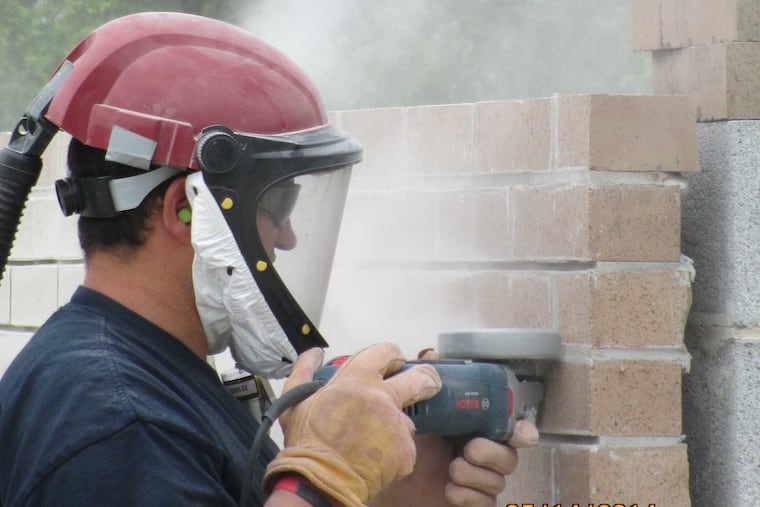New silica dust regs confuse, concern contractors
Bricklayers' union leader Dennis Pagliotti believes inhaling crystalline silica dust contributed to his father's death from lung cancer at age 59. Peter Pagliotti had spent his life working as a bricklayer. That's why, for him, new regulations requiring contractors to reduce silica dust on construction sites are important. Conscientious contractors agree, but say there are problems with the new regs, set to go into effect in September. The chief complaint? Too vague.

Judging by the medical records, lung cancer killed Dennis Pagliotti's father in 1996. He was 59.
But Pagliotti, who leads Local 1 of the Bricklayers and Allied Craft Workers union, suspects another culprit for his father's cancer: silicosis, the lung disease common among construction workers, including lifelong bricklayers such as Pagliotti's father, Peter. The disease is caused by inhaling crystalline silica dust, created when drills and saws buzz into bricks, concrete, and mortar.
"That's why this is near and dear to my heart," Pagliotti said. On Wednesday, in the union's banquet hall in Northeast Philadelphia, Pagliotti's union assembled nearly 50 brick and mason contractors to learn about new worker safety regulations involving how silica dust needs to be handled on job sites.
The rules, from the U.S. Labor Department's Occupational Safety and Health Administration (OSHA) had been set to go into effect next month. When President Trump came into office, the start date was pushed back to September.
After the two-hour session, the contractors were confused and concerned. "We want our workers to be as safe as possible," said Jan Jeffries, project manager and a co-owner of the Masonry Preservation Group Inc. in Merchantville. The problem is that the regulations set higher standards than all the available and practical health and safety techniques can accomplish, he and fellow owners said.
For example, their work restoring church steeples and high towers often has workers suspended in a harness or in the cabin of a crane. Two typical techniques for eliminating dust — using a vacuum to suck up the dust and applying water to keep the dust down — aren't easily applied in those situations, they said. Their workers always wear respirators, but the respirators alone do not always provide enough protection to meet the new standard.
One speaker at Wednesday's event, James Touey, labor liaison from Philadelphia's OSHA office, tried to reassure the contractors, telling them that OSHA wouldn't hammer them if they showed evidence of good faith to follow the regulations. But Jeffries said he wasn't reassured. "That's a lot of faith on our side."
The disease kills more than 100 people a year, according to the government. In 1999, 185 people died. In 2011, when construction tanked in the post-recession period, the number fell to a low of 88, but rose to 113 as building picked up. With 349 deaths, Pennsylvania led the nation in silicosis fatalities, according to a study that tracked silicosis deaths between 1968 and 2005. Construction workers — and not just bricklayers — are the most likely to get the disease, which is also associated with lung cancer and autoimmune disorders.
Silicosis causes scarring in the lungs, making it harder to breathe. Symptoms can take more than a decade to develop, or can happen quickly, depending on exposure. Lately, there has been an increase in silicosis fatalities among younger workers, leading experts, such as industrial hygienist Pam Susi, who spoke at Wednesday's gathering, to conclude that young workers are being exposed to more hazards on the job.
Touey and Susi explained that under the new regulations, companies should make a good-faith effort to determine whether their workers are likely to fall short of safety standards on the job and have a competent person on site who can make a judgment on whether air monitoring is required. The regulations, they said, cover employees working on an actual covered task. Employees in the vicinity aren't impacted. People who wear respirators are allowed to wear them for only 30 days a year, and have to be medically certified to continue working.
As the two talked, the buzz in the room grew louder. What constitutes a good-faith effort? What defines a competent person? How near or far is "in the vicinity"? Would the employees have to be medically certified each time they switched employers? After all, many union members work for multiple contractors in a year.
"Everything is so vague," complained Mark Cannon, an executive with Giles J. Cannon Inc., a masonry contractor in Collingdale. "That's what bothers me."
Touey promised that he would forward their concerns to the higher-ups in his agency. But, meanwhile, he had a piece of practical advice to help them avoid attracting the attention of OSHA inspectors.
Use vacuums and water to keep the dust down. "If you're blowing dust all over the place, those jobs will be obvious."